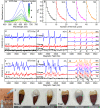Pyro-catalysis for tooth whitening via oral temperature fluctuation
- PMID: 35906221
- PMCID: PMC9338087
- DOI: 10.1038/s41467-022-32132-3
Pyro-catalysis for tooth whitening via oral temperature fluctuation
Abstract
Tooth whitening has recently become one of the most popular aesthetic dentistry procedures. Beyond classic hydrogen peroxide-based whitening agents, photo-catalysts and piezo-catalysts have been demonstrated for non-destructive on-demand tooth whitening. However, their usage has been challenged due to the relatively limited physical stimuli of light irradiation and ultrasonic mechanical vibration. To address this challenge, we report here a non-destructive and convenient tooth whitening strategy based on the pyro-catalysis effect, realized via ubiquitous oral motion-induced temperature fluctuations. Degradation of organic dyes via pyro-catalysis is performed under cooling/heating cycling to simulate natural temperature fluctuations associated with intake and speech. Teeth stained by habitual beverages and flavorings can be whitened by the pyroelectric particles-embedded hydrogel under a small surrounding temperature fluctuation. Furthermore, the pyro-catalysis-based tooth whitening procedure exhibits a therapeutic biosafety and sustainability. In view of the exemplary demonstration, the most prevalent oral temperature fluctuation will enable the pyro-catalysis-based tooth whitening strategy to have tremendous potential for practical applications.
© 2022. The Author(s).
Conflict of interest statement
The authors declare no competing interests.
Figures







Similar articles
-
Piezo-catalysis for nondestructive tooth whitening.Nat Commun. 2020 Mar 12;11(1):1328. doi: 10.1038/s41467-020-15015-3. Nat Commun. 2020. PMID: 32165627 Free PMC article.
-
Photothermal-Enhanced Fenton-like Catalytic Activity of Oxygen-Deficient Nanotitania for Efficient and Safe Tooth Whitening.ACS Appl Mater Interfaces. 2021 Aug 4;13(30):35315-35327. doi: 10.1021/acsami.1c06774. Epub 2021 Jul 22. ACS Appl Mater Interfaces. 2021. PMID: 34291910
-
Sono-Catalytic Tooth Whitening and Oral Health Enhancement with Oxygen Vacancies-Enriched Mesoporous TiO2 Nanospheres: A Nondestructive Approach for Daily Tooth Care.ACS Biomater Sci Eng. 2024 Oct 14;10(10):6634-6647. doi: 10.1021/acsbiomaterials.4c01185. Epub 2024 Sep 30. ACS Biomater Sci Eng. 2024. PMID: 39348292
-
The art and science of tooth whitening.J Mass Dent Soc. 2005 Winter;53(4):34-7. J Mass Dent Soc. 2005. PMID: 15828604 Review.
-
Safety issues of tooth whitening using peroxide-based materials.Br Dent J. 2013 Jul;215(1):29-34. doi: 10.1038/sj.bdj.2013.629. Br Dent J. 2013. PMID: 23846062 Review.
Cited by
-
The next generation of dental treatments: Leveraging smart-responsive nanomaterials for unique oral environments.Mater Today Bio. 2025 Jul 5;33:102057. doi: 10.1016/j.mtbio.2025.102057. eCollection 2025 Aug. Mater Today Bio. 2025. PMID: 40809405 Free PMC article. Review.
-
Mechanical properties and curing kinetics of bio-based benzoxazine-epoxy copolymer for dental fiber post.Bioresour Bioprocess. 2023 Sep 16;10(1):62. doi: 10.1186/s40643-023-00684-x. Bioresour Bioprocess. 2023. PMID: 38647586 Free PMC article.
-
Characteristic Evaluation and Finite Element Analysis of a New Glass Fiber Post Based on Bio-Derived Polybenzoxazine.Int J Mol Sci. 2025 Mar 9;26(6):2444. doi: 10.3390/ijms26062444. Int J Mol Sci. 2025. PMID: 40141088 Free PMC article.
-
Self-Assembled Nanofibrous Membranes by Electrospinning as Efficient Dye Photocatalysts for Wastewater Treatment.Polymers (Basel). 2023 Jan 9;15(2):340. doi: 10.3390/polym15020340. Polymers (Basel). 2023. PMID: 36679221 Free PMC article.
-
Transparent integrated pyroelectric-photovoltaic structure for photo-thermo hybrid power generation.Nat Commun. 2024 Apr 24;15(1):3466. doi: 10.1038/s41467-024-47483-2. Nat Commun. 2024. PMID: 38658539 Free PMC article.
References
-
- Perdigo J, Baratieri LN, Arcari GM. Contemporary trends and techniques in tooth whitening: A review. Pr. Proced. Aesthet. Dent. 2004;16:185–192. - PubMed
Publication types
MeSH terms
Substances
LinkOut - more resources
Full Text Sources

